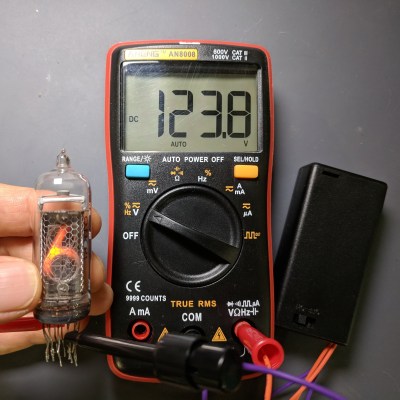[The LED Artist] often found a need for a relatively high voltage (100 to 200 Volt) but low current DC power supply, and it turns out that a small HV generator that uses a single AA cell only took about an hour to make. The device ended up being a pretty handy tool for testing things like LED filaments (which have a forward voltage of over 60 V), or even neon and nixie tubes.
 The device’s low current means that nixie and neon elements won’t light up very brightly, but they will light up enough to verify function and operation. [The LED Artist] reports that touching the output terminals of the generator only causes a slight tingling sensation.
The device’s low current means that nixie and neon elements won’t light up very brightly, but they will light up enough to verify function and operation. [The LED Artist] reports that touching the output terminals of the generator only causes a slight tingling sensation.
Open-circuit voltage generated from a single AA cell is about 200 V, but that voltage drops rapidly under any kind of load. Even regular LEDs can be safely lit with the circuit, with less than a milliamp being supplied at the two to three volts at which most regular LEDs operate.
[The LED Artist] fit the device into a two-AA battery holder, with a single AA cell on one side and the circuit in the other, and says it’s one of the more useful tools they’ve ever made. LED filaments are fairly common nowadays, but if they intrigue you, don’t forget that [Mike Harrison] covered everything you need to know about experimenting with them.















“only took about an hour to make.” Uh, BS?? First of all, [The LED Artist] says “a couple of hours to put together”, which itself is doubtful. “Put together” can mean anything from “design and fabricate, from scratch” to “mount the major components in a box”. Since this clearly involved layout and etching of a PCB, we’re already stretching the notion of “a couple of hours”, before you mount a single component.
This is a GREAT idea, though: having a single module that can light up anything from a single LED to a whole string of them, to neon lights and Nixie tubes, is pretty awesome.
Useful piece of gear for testing all sorts of things I’d add a fairly precise constant current limit trim. I have one of these 2G Ohm meggers that generates approx 500vdc mainly insulation/creepage testing related, would be good to have a constant current option with negligible as in lowest capacitance after that, then can set a high coarse voltage and use it to test the more gentle avalanche voltages of reverse biased devices mostly transistors and diodes etc. Thanks for post :-)
I think it would be nice in the form factor that I made for my 3.3/5V booster: https://hackaday.io/project/7050-boostick-small-aa-voltage-booster A person could make a whole little family of different voltages to plug into breadboards.
Hopefully in highly contrasting colors. #%&&!!, that was the 10 kV one!